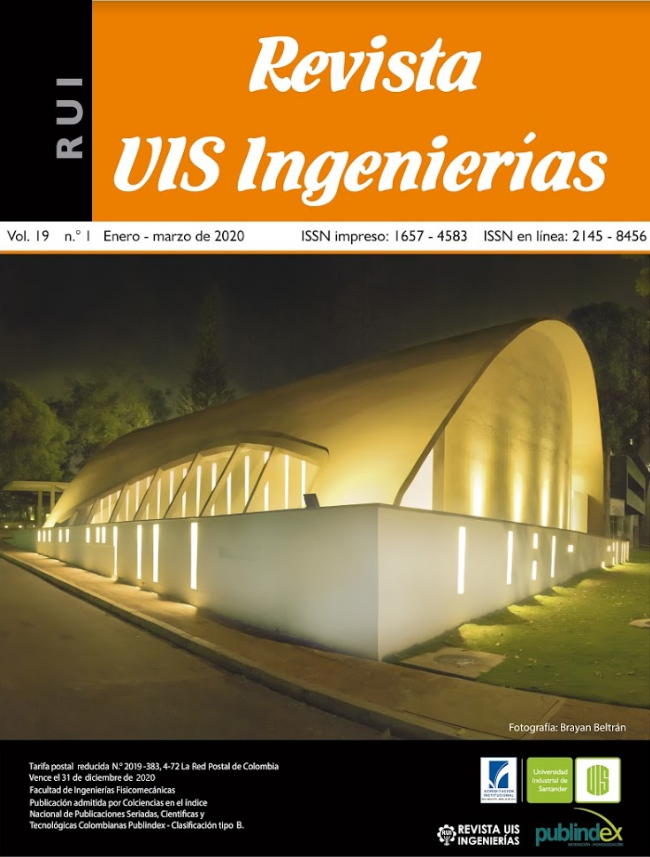Compressive strength of partially stiffened cylinders at elevated temperatures
Published 2020-01-30
Keywords
- compressive strength,
- stainless steel,
- finite element analysis,
- elevated temperature,
- longitudinal stiffening
How to Cite
Copyright (c) 2020 Revista UIS Ingenierías

This work is licensed under a Creative Commons Attribution-NoDerivatives 4.0 International License.
Abstract
This work presents the finite element analysis of partially stiffened cylinders subjected to axial compression at elevated temperatures. The compressive strength is calculated for self-weight conditions and the influence of the temperature on the material response is also investigated. In the oil industry, pressure vessels are commonly used operating at complex design conditions such as high-pressure profiles and/or elevated temperature gradients which affect considerably the structural response of inner components. Among them, risers become sensitive steel elements withstanding heavy compressive loading due to self-weight, as well as, insulation elements added to protect them from the elevated temperature gradient. Most risers structurally fail at the bottom end due to buckling caused by self-weight and temperature effects. To remediate this situation and to guarantee the integrity of the riser, longitudinal stiffeners are welded at the bottom end. Hence, a proper determination of the compressive strength of the cylinder, taking into account the influence of the longitudinal stiffening and the corresponding temperature, is required. Results indicate that the use of longitudinal stiffeners in deformed cylinders increases the strength to buckling in percentages that vary according to the cross-section of the profiles.
Downloads
References
[2] S. Timoshenko, Theory of elastic stability. New York: McGraw Hill, 1910.
[3] W. Koiter, “On the stability of elastic equilibrium,” University of Delf, 1945.
[4] B. Budiansky and J. W. Hutchinson, “Dynamic buckling of imperfection-sensitive structures,” in Applied Mechanics, Berlin, Heidelberg: Springer Berlin Heidelberg, 1966, pp. 636–651.
[5] J. M. T. Thompson and G. W. Hunt, A general theory of elastic stability. London: Wiley, 1973.
[6] A. B. Brush D, Buckling of Bars, Plates and Shells. New York: McGraw-Hill, 1975.
[7] J. Arbocz, “Post-buckling behaviour of structures numerical techniques for more complicated structures,” in Buckling and Post-Buckling, Berlin/Heidelberg: Springer-Verlag, 1987, pp. 83–142.
[8] X. Ding, R. Coleman, and J. M. Rotter, “Technique for Precise Measurement of Large-Scale Silos and Tanks,” J. Surv. Eng., vol. 122, no. 1, pp. 14–25, 1996, doi:10.1061/(asce)0733-9453(1996)122:1(14).
[9] M. Pircher and R. Bridge, “The influence of circumferential weld-induced imperfections on the buckling of silos and tanks,” J. Constr. Steel Res., vol. 57, no. 5, pp. 569–580, May 2001, doi:10.1016/S0143-974X(00)00027-4.
[10] F. Mahboubi Nasrekani and H. Eipakchi, “Axisymmetric Buckling of Cylindrical Shells with Nonuniform Thickness and Initial Imperfection,” Int. J. Steel Struct., pp. 1–11, Aug. 2018, doi:10.1007/s13296-018-0132-9.
[11] J. C. Amazigo, “Buckling of Stochastically Imperfect Structures,” in Buckling of Structures, Berlin, Heidelberg: Springer Berlin Heidelberg, 1976, pp. 172–182.
[12] J. Arbocz, “The Imperfection Data Bank, a Mean to Obtain Realistic Buckling Loads,” in Buckling of Shells, Berlin, Heidelberg: Springer Berlin Heidelberg, 1982, pp. 535–567.
[13] M. K. Chryssanthopoulos, M. J. Baker, and P. J. Dowling, “Imperfection Modeling for Buckling Analysis of Stiffened Cylinders,” J. Struct. Eng., vol. 117, no. 7, pp. 1998–2017, 1991, doi:10.1061/(asce)0733-9445(1991)117:7(1998).
[14] L.-W. Chen and L.-Y. Chen, “Thermal postbuckling analysis of laminated composite plates by the finite element method,” Compos. Struct., vol. 12, no. 4, pp. 257–270, Jan. 1989, doi:10.1016/0263-8223(89)90075-5.
[15] C. A. Meyers and M. W. Hyer, “Thermal buckling and postbuckling of symmetrically laminated composite plates,” J. Therm. Stress., vol. 14, no. 4, pp. 519–540, Oct. 1991, doi:10.1080/01495739108927083.
[16] H.-S. Shen, “Thermal postbuckling analysis of imperfect stiffened laminated cylindrical shells,” Int. J. Non. Linear. Mech., vol. 32, no. 2, pp. 259–275, Mar. 1997, doi:10.1016/S0020-7462(96)00054-6.
[17] M. J. Lewandowski, M. Gajewski, and M. Gizejowski, “Numerical analysis of influence of intermediate stiffeners setting on the stability behaviour of thin-walled steel tank shell,” Thin-Walled Struct., vol. 90, pp. 119–127, May 2015, doi:10.1016/j.tws.2015.01.019.
[18] Q.-V. Vu, V.-H. Truong, G. Papazafeiropoulos, C. Graciano, and S.-E. Kim, “Bend-buckling strength of steel plates with multiple longitudinal stiffeners,” J. Constr. Steel Res., vol. 158, pp. 41–52, Jul. 2019, doi:10.1016/j.jcsr.2019.03.006.
[19] J. D. Argüello-Bastos, C. A. Ruiz-Florián, O. A. González-Estrada, A. D. Pertuz-Comas, and A. Martínez-Amariz, “Compression tests performed in reinforced rigid matrix composite varying the reinforcement material,” J. Phys. Conf. Ser., vol. 1126, p. 012007, Nov. 2018, doi:10.1088/1742-6596/1126/1/012007.
[20] J. Martínez, E. Casanova, C. Graciano, and O. A. González-Estrada, “Sensitivity analysis of a member under compression via Monte Carlo method,” Rev. UIS Ing., vol. 17, no. 2, pp. 179–184, 2018.
[21] A. Ayestarán, C. Graciano, and O. A. González-Estrada, “Resistencia de vigas esbeltas de acero inoxidable bajo cargas concentradas mediante análisis por elementos finitos,” Rev. UIS Ing., vol. 16, no. 2, pp. 61–70, Sep. 2017, doi:10.18273/revuin.v16n2-2017006.
[22] ABAQUS, ABAQUS/standard user’s manual, v.6.9. Pawtucket, Rhode Island: Hibbitt, Karlsson & Sorensen, Inc., 2009.
[23] S.-E. Kim and C.-S. Kim, “Buckling strength of the cylindrical shell and tank subjected to axially compressive loads,” Thin-Walled Struct., vol. 40, no. 4, pp. 329–353, Apr. 2002, doi:10.1016/S0263-8231(01)00066-0.
[24] Y. Song, “Buckling of shells under non-uniform stress states,” Hong Kong Polytechnic University, 2002.
[25] C. Y. Song, J. G. Teng, and J. M. Rotter, “Imperfection sensitivity of thin elastic cylindrical shells subject to partial axial compression,” Int. J. Solids Struct., vol. 41, no. 24–25, pp. 7155–7180, Dec. 2004, doi:10.1016/j.ijsolstr.2004.05.040.
[26] ASME BPVC.II.D, Materials, Part D, Properties. New York: ASME, 2015.
[27] W. Ramberg and W. Osgood, “Determination of stress-strain curves by three parameters. Technical Note No 503,” 1941.
[28] E. Mirambell and E. Real, “On the calculation of deflections in structural stainless steel beams: an experimental and numerical investigation,” J. Constr. Steel Res., vol. 54, no. 1, pp. 109–133, Apr. 2000, doi:10.1016/S0143-974X(99)00051-6.
[29] K. Abdella, “Inversion of a full-range stress–strain relation for stainless steel alloys,” Int. J. Non. Linear. Mech., vol. 41, no. 3, pp. 456–463, Apr. 2006, doi:10.1016/j.ijnonlinmec.2005.10.002.
[30] E. Riks, “An incremental approach to the solution of snapping and buckling problems,” Int. J. Solids Struct., vol. 15, no. 7, pp. 529–551, 1979, doi:10.1016/0020-7683(79)90081-7.

